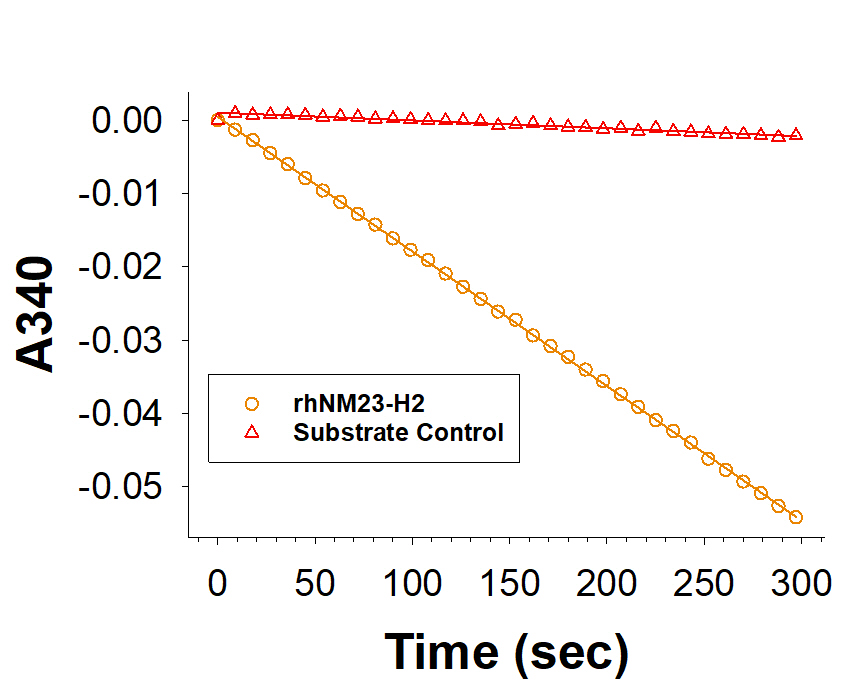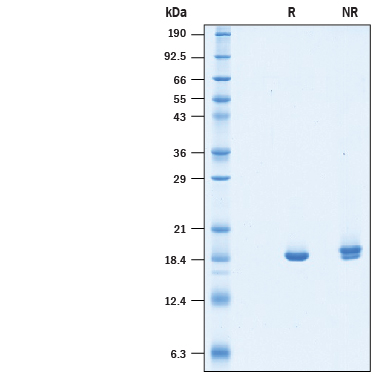Recombinant Human NM23-H2 His-tag Protein, CF Summary
Product Specifications
The specific activity is >500,000 pmol/min/μg, as measured under the described conditions.
Met1-Glu152
with a C-terminal 6-His tag
Analysis
Product Datasheets
Carrier Free
CF stands for Carrier Free (CF). We typically add Bovine Serum Albumin (BSA) as a carrier protein to our recombinant proteins. Adding a carrier protein enhances protein stability, increases shelf-life, and allows the recombinant protein to be stored at a more dilute concentration. The carrier free version does not contain BSA.
In general, we advise purchasing the recombinant protein with BSA for use in cell or tissue culture, or as an ELISA standard. In contrast, the carrier free protein is recommended for applications, in which the presence of BSA could interfere.
10466-NM
| Formulation | Supplied as a 0.2 μm filtered solution in Tris, NaCl and DTT. |
| Shipping | The product is shipped with dry ice or equivalent. Upon receipt, store it immediately at the temperature recommended below. |
| Stability & Storage: | Use a manual defrost freezer and avoid repeated freeze-thaw cycles.
|
Assay Procedure
- Assay Buffer: 50 mM Tris, 10 mM MgCl2, 100 mM KCl, pH 7.5
- Recombinant Human NM23-H2 His-tag (rhNM23-H2) (Catalog # 10466-NM)
- Substrate: Thymidine 5'-diphosphate (TDP) (Sigma, Catalog # T9375), 40 mM stock in 10 mM Sodium Borate, pH 9.0
- Recombinant Human PKM2 (rhPKM2) (Catalog # 7244-PK)
- Recombinant Human Lactate Dehydrogenase A/LDHA (rhLDHA) (Catalog # 9158-HA)
- Adenosine 5'-triphosphate (ATP) (Sigma, Catalog # A7699), 400 mM stock in deionized water
- beta -Nicotinamide adenine dinucleotide, reduced disodium salt hydrate ( beta -NADH) (Sigma, Catalog # N8129), 20 mM stock in 0.1 M Sodium Borate, pH 9.0
- Phospho(enol)pyruvic acid (PEP) (Sigma, Catalog # P0564), 50 mM stock in deionized water
- 96-well clear Plate (Catalog # DY990)
- Plate Reader (Model: SpectraMax Plus by Molecular Devices) or equivalent
- Prepare Reaction Mixture containing 20 µg/mL rhPKM2, 5 µg/mL rhLDHA, 4 mM ATP, 400 µM beta -NADH, 2 mM PEP and 2 mM TDP in Assay Buffer.
- Incubate Reaction Mixture at room temperature for 5 minutes.
- Dilute rhNM23-H2 to 0.01 ng/µL in Assay Buffer.
- In a plate, load 50 µL of 0.01 ng/µL rhNM23-H2 and start the reaction by adding 50 µL of Reaction Mixture. Include a Control containing 50 µL of Assay Buffer and 50 µL of Reaction Mixture.
- Read at an absorbance of 340 nm in kinetic mode for 5 minutes.
- Calculate specific activity:
Specific Activity (pmol/min/µg) = | Adjusted Vmax* (OD/min) x well volume (L) x 1012 pmol/mol x (-1) |
| ext. coeff** (M-1cm-1) x path corr.*** (cm) x amount of enzyme (µg) |
*Adjusted for Control
**Using the extinction coefficient 6220 M-1cm-1
***Using the path correction 0.32 cm
Note: the output of many spectrophotometers is in mOD
- rhNM23-H2: 0.0005 µg
- TDP: 1 mM
- ATP: 2 mM
- beta -NADH: 200 µM
- PEP: 1 mM
- rhPKM2: 1 µg
- rhLDHA: 0.25 µg
Scientific Data
 View Larger
View Larger
Recombinant Human NM23-H2 His-tag (Catalog # 10466-NM) is measured by its ability to convert thymidine diphosphate and adenosine triphosphate to thymidine triphosphate and adenosine diphosphate in a coupled assay.
 View Larger
View Larger
2 μg/lane of Recombinant Human NM23-H2 His-tag (Catalog # 10466-NM) was resolved with SDS-PAGE under reducing (R) and non-reducing (NR) conditions and visualized by Coomassie® Blue staining, showing a band at 19 kDa under reducing conditions.
Reconstitution Calculator
Background: NM23-H2
Non-metastatic Protein 23 Homolog 2 (NM23-H2), also known as Nucleoside diphosphate kinase B (NDPK-B), is a group 1 member of the NDPK family encoded by the NME2 (non metastatic cell) gene (1,2). NDPKs are well-known as housekeeping genes that maintain the balance of nucleoside triphosphate levels by transferring a phosphate group from a nucleoside triphosphate to nucleoside diphosphate. NM23-H2 is a cytosolic protein that forms active hexamers composed of a trimer of dimers (3). The active hexamer contains a "head" region with substrate binding and catalytic activity as well as a Kpn loop and C-terminal extensions that stabilize the structure (3). NM23-H2 (NDPK-B) shares significant homology with NM23-H1 (NDPK-A) at 88% identity (3). In spite of significant homology and catalytic function between these isoforms, the differing amino acids present on the lateral surface of the hexamers lead to specific interactions with other proteins and ultimately result in diverging cellular distribution and function in cells (2). Both NM23-H2 and NM23-H1 have been reported to act as protein histidine kinases (4-7). NM23-H2 alone has been shown to reversibly histidine phosphorylate beta subunit of trimeric G proteins (4), the Kca3.1 potassium channel (5) and the TRPV5 calcium channel (6) implicating NM23-H2 to have a role in heart failure and activation of B and T cells. Additionally, NM23-H2 has specifically been shown to form a complex with the cystic fibrosis transmembrane conductance regulator (CFTR) (1) to regulate chloride channels. NM23-H2 knockout mice have a defect in potassium channel activation, cytokine production in T cells (8), and have been shown to decrease class switch recombination (CSR) in B cells during an immune response (9).
- Borthwick, L.A. et al. (2016) PLoS One. 11:e0149097.
- Boissan, M. et al. (2018) Lab. Invest. 98:164.
- Webb, P.A. et al. (1995) J. Mol. Biol. 251:574.
- Cuello, F. et al. (2003) J. Biol. Chem. 278:7220.
- Srivastava, S. et al. (2006) Mol. Cell. 24:665.
- Cai, X. et al. (2014) Mol. Bol. Cell 25:1244.
- Attwood, P.V. et al. (2018) Lab. Invest. 98:283.
- Di, L. et al. (2010) J. Biol. Chem. 285:38765.
- Zheng, S. et al. (2019) FEBS Lett. 593:80.
FAQs
No product specific FAQs exist for this product, however you may
View all Proteins and Enzyme FAQsReviews for Recombinant Human NM23-H2 His-tag Protein, CF
There are currently no reviews for this product. Be the first to review Recombinant Human NM23-H2 His-tag Protein, CF and earn rewards!
Have you used Recombinant Human NM23-H2 His-tag Protein, CF?
Submit a review and receive an Amazon gift card.
$25/€18/£15/$25CAN/¥75 Yuan/¥1250 Yen for a review with an image
$10/€7/£6/$10 CAD/¥70 Yuan/¥1110 Yen for a review without an image
